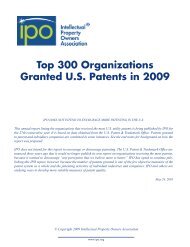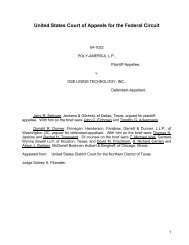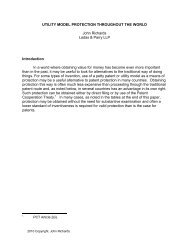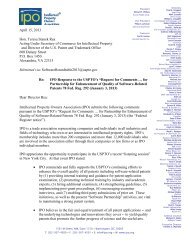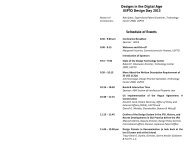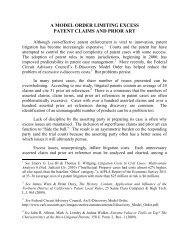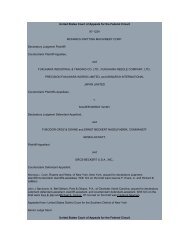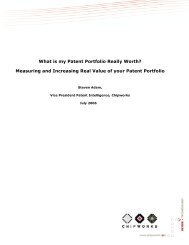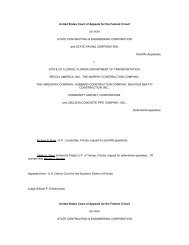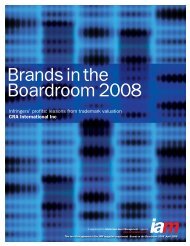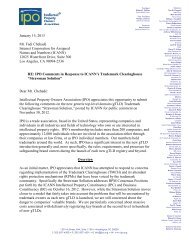Ruiz v. A.B. Chance Co.
Ruiz v. A.B. Chance Co.
Ruiz v. A.B. Chance Co.
You also want an ePaper? Increase the reach of your titles
YUMPU automatically turns print PDFs into web optimized ePapers that Google loves.
enough express and necessarily implied findings to know the basis of the trial court’s opinion.<br />
Id. at 873, 228 USPQ at 98 (internal citation omitted). The necessity of Graham findings is especially<br />
important where the invention is less technologically complex, as is the case here. See In re Dembiczak, 175<br />
F.3d 994, 999, 50 USPQ2d 1614, 1617 (Fed. Cir. 1999), abrogated on other grounds by In re Gartside, 203<br />
F.3d 1305, 53 USPQ2d 1769 (Fed. Cir. 2000). In such a case, the danger increases that "the very ease with<br />
which the invention can be understood may prompt one ‘to fall victim to the insidious effect of a hindsight<br />
syndrome wherein that which only the inventor taught is used against its teacher.’" Id. (internal citation<br />
omitted). The fact that the district court does not mention Graham is not dispositive, as it is not reversible<br />
error if "the required factual determinations were actually made and it is clear that they were considered<br />
while applying the proper legal standard of obviousness." Specialty <strong>Co</strong>mposites v. Cabot <strong>Co</strong>rp., 845 F.2d 981,<br />
990, 6 USPQ2d 1601, 1607 (Fed. Cir. 1988); see also Loctite, 781 F.2d at 873, 228 USPQ at 98.<br />
The district court’s failure to base its obviousness inquiry on the explicit findings relating to<br />
the Graham factors can require that the judgment be vacated and the case remanded for those findings to be<br />
made. In Custom Accessories, we said:<br />
If, on review of a determination of obviousness, an appellant shows that the district court incorrectly applied<br />
the law, we will not reverse (i.e., hold that defendant below failed to prove obviousness) unless appellant<br />
also convinces us that a proper application of the law to the facts of record would change the result.<br />
Sometimes, however, an appellant will convince us that the law was incorrectly applied, but there are<br />
inadequate findings by the district court to enable us to determine independently whether defendant below<br />
did or did not prove that the invention would have been obvious . . . In such circumstances, rather than find<br />
material facts ourselves, we must remand to allow the district court to do so.<br />
Custom Accessories, 807 F.2d at 963, 1 USPQ at 1202; see also Jones, 727 F.2d at 1531, 220 USPQ at 1027<br />
("Where the evidence is conflicting or credibility determinations are required, the judgment should be<br />
vacated rather than reversed, and the case should be remanded for further proceedings."); Loctite, 781 F.2d<br />
at 875, 228 USPQ at 97 (vacating and remanding due to failure to make Graham findings); Bausch & Lomb,<br />
Inc. v. Barnes-Hind/Hydrocurve, Inc., 796 F.2d 443, 446, 230 USPQ 416, 418 (Fed. Cir. 1986) (vacating trial<br />
court opinion and remanding due to absence of Graham findings);Greenwood v. Hattori Seiko <strong>Co</strong>. Ltd., 900<br />
F.2d 238, 241, 14 USPQ2d 1474, 1474 (Fed. Cir. 1990) (vacating summary judgment of obviousness<br />
because district court failed to undertake the required Graham analysis).<br />
1. Scope and <strong>Co</strong>ntent of the Prior Art/Differences Between the Claimed Invention and the Prior Art<br />
The district court erred in failing to make clear and particular findings as to why the Gregory patents and the<br />
Fuller and Rupiper method are within the appropriate scope of the prior art in determining the obviousness<br />
of the ’368 and ’107 patents. The scope of the prior art includes art that is "reasonably pertinent to the<br />
particular problem with which the invention was involved." Stratoflex, Inc. v. Aeroquip <strong>Co</strong>rp., 713 F.2d 1530,<br />
1535, 218 USPQ 871, 876 (Fed. Cir. 1983). In order to prevent a hindsight-based obviousness analysis, we<br />
have clearly established that the relevant inquiry for determining the scope and content of the prior art is<br />
whether there is a reason, suggestion, or motivation in the prior art or elsewhere that would have led one of<br />
ordinary skill in the art to combine the references. See, e.g., In re Rouffet, 149 F.3d 1350, 1359, 47 USPQ2d<br />
1453, 1459 (Fed. Cir. 1998) ("[T]he Board must identify specifically . . . the reasons one of ordinary skill in<br />
the art would have been motivated to select the references and to combine them to render the claimed<br />
invention obvious."); In re Dembiczak, 175 F.3d at 999, 50 USPQ2d at 1617 ("Our case law makes clear that<br />
the best defense against the subtle but powerful attraction of a hindsight-based obviousness analysis is<br />
rigorous application of the requirement for a showing of the teaching or motivation to combine prior art<br />
references."). "Determining whether there is a suggestion or motivation to modify a prior art reference is one<br />
aspect of determining the scope and content of the prior art, a fact question subsidiary to the ultimate<br />
conclusion of obviousness." Sibia Neurosciences, Inc. v. Cadus Pharma. <strong>Co</strong>rp., 225 F.3d 1349, 1356, 55<br />
USPQ2d 1927, 1931 (Fed. Cir. 2000); Tec Air, Inc. v. Denso Mfg., Inc., 192 F.3d 1353, 1359, 52 USPQ2d<br />
1294, 1298 (Fed. Cir. 1999) (stating that the factual underpinnings of obviousness include whether a<br />
reference provides a motivation to combine its teachings with those of another reference).<br />
The district court concluded that it would have been obvious to combine screw anchors and metal brackets,<br />
because the need for a bracket "was apparent." Because there is "a general rule that combination claims<br />
can consist of combinations of old elements as well as new elements," Clearstream Wastewater Sys. v. Hydro-<br />
Action, Inc., 206 F.3d 1440, 1446, 54 USPQ2d 1185, 1189-90 (Fed. Cir. 2000), "[t]he notion . . . that<br />
combination claims can be declared invalid merely upon finding similar elements in separate prior patents<br />
would necessarily destroy virtually all patents and cannot be the law under the statute, § 103." Panduit <strong>Co</strong>rp.



